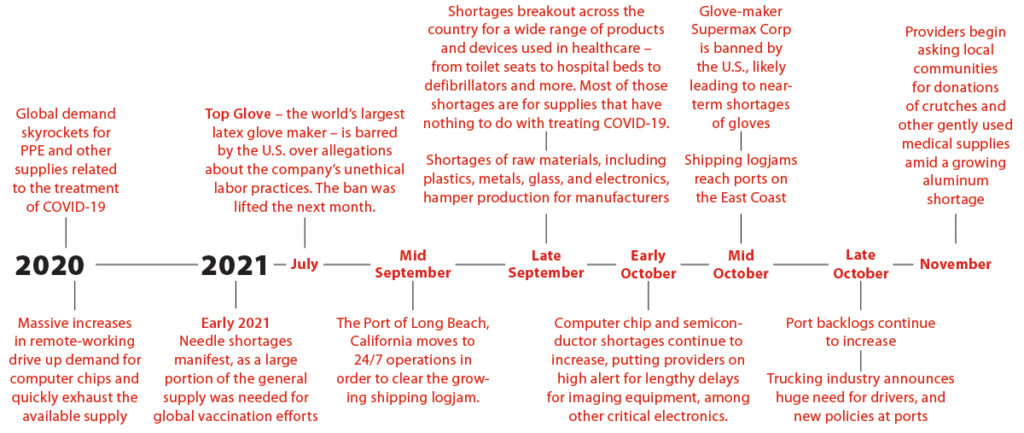December 2021 – Repertoire Magazine
By Alan Cherry
At the outset of the pandemic, the sudden spike in demand caused massive shortages for personal protective equipment such as masks, gowns, and gloves. Manufacturers were able to ramp up supply and alleviate those shortages in most places by the end of the year.
In early 2021, providers began encountering shortages for needles, as a large portion of the general supply was needed for impending vaccine distribution.
Earlier this spring, a steep downward trend in COVID cases worldwide had many starting to grow concerned about the bullwhip effect created by the lag between demand and fulfillment. Then, a second wave of COVID spurred by the Delta variant added more fuel to the fire of shortages in supply chain industries around the world.
By summer of this year, the distribution section of supply chain became the emergent problem. Cargo began stacking up in ports as a dearth of truck drivers, among other factors, meant that containers could not be moved away from ports and taken to their final destination quickly enough. This led to a huge backlog of ships waiting for days or weeks in order to offload cargo.
September
In mid-September, the port of Long Beach, California moved to 24/7 operations in order to clear the growing shipping logjam. By the end of the month, medical supply shortages began to crop up all over the country for a host of critical items needed at medical facilities – from exam tables and heart defibrillators to crutches and IV poles, and more.
Unlike earlier in the pandemic, the new shortages were generally for supplies that had nothing to do with treating COVID.
Meanwhile, shortages of raw materials, including plastics, metals, glass, and electronics, hampered production for manufacturers.
In the case of exam tables, tight supplies of electronic controllers, metal, and even the foam padding used to build them were hampering producers’ ability to meet product demand. Estimated wait times for some products grew from 3-6 weeks to 5-6 months.
Even wait times for critical items like heart defibrillators – which had formerly taken only two weeks to deliver – jumped up to as long as three months or more.
October
From the beginning, the global supply crunch for computer chips – fueled by soaring demand for electronics amid the increase in remote working – had disrupted car production and pushed up the prices of laptops and printers.
Hospital supply chain teams had been on “high alert” for shortages of thousands of items containing semiconductors for six months. By October, medical device makers were also feeling the crunch. In a Deloitte survey of medical technology companies, every single respondent reported supply issues. Hospitals were also experiencing long order delays because of the semiconductor shortage for new CT scanners, defibrillators, ultrasound machines, and telemetry monitors.
PPE shortages had become less dire thanks to manufacturers ramping up supply. However, in late October, the U.S. federal government banned glove imports from one of the largest suppliers, Malaysian glove maker Supermax Corp, over alleged forced labor practices at the company. Supermax’s bigger Malaysian rival, Top Glove – the world’s largest latex glove maker – had been barred in July by the U.S. over similar allegations. That ban was lifted in September after the company resolved the labor issues.
As retailers began importing stock for the holiday crunch, ports on both coasts became even more congested. The backup caused the Ports of Los Angeles, the second busiest port in the U.S., to also move to 24/7 operations to help ease the ongoing supply chain logjams.
Even with both ports operating around the clock, tens of thousands of containers were stuck floating in limbo. Dozens of ships were lined up waiting to offload, with waiting times stretching to three weeks.
By the beginning of November, a growing shortage of aluminum had providers around the country asking their local communities to donate crutches and other “gently medical supplies.” The aluminum shortage could become a much bigger problem in the near future, since the end of the year is typically the busiest time for orthopedic surgeries as people squeeze in the surgeries prior the end of the year.
